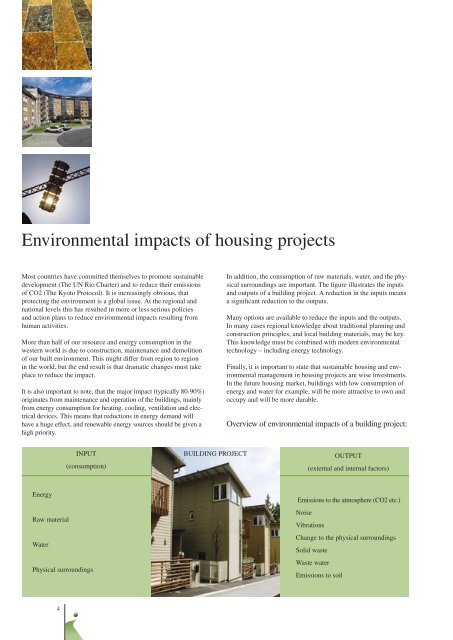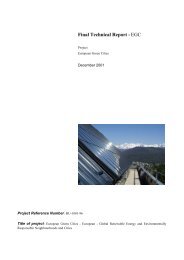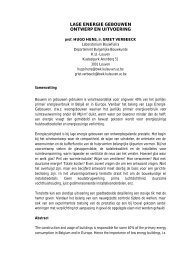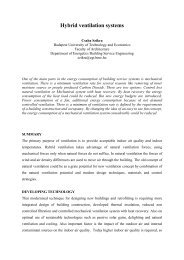Manual and Guidelines for Sustainable Housing Projects
Manual and Guidelines for Sustainable Housing Projects
Manual and Guidelines for Sustainable Housing Projects
Create successful ePaper yourself
Turn your PDF publications into a flip-book with our unique Google optimized e-Paper software.
Environmental impacts of housing projects<br />
Most countries have committed themselves to promote sustainable<br />
development (The UN Rio Charter) <strong>and</strong> to reduce their emissions<br />
of CO2 (The Kyoto Protocol). It is increasingly obvious, that<br />
protecting the environment is a global issue. At the regional <strong>and</strong><br />
national levels this has resulted in more or less serious policies<br />
<strong>and</strong> action plans to reduce environmental impacts resulting from<br />
human activities.<br />
More than half of our resource <strong>and</strong> energy consumption in the<br />
western world is due to construction, maintenance <strong>and</strong> demolition<br />
of our built environment. This might differ from region to region<br />
in the world, but the end result is that dramatic changes must take<br />
place to reduce the impact.<br />
It is also important to note, that the major impact (typically 80-90%)<br />
originates from maintenance <strong>and</strong> operation of the buildings, mainly<br />
from energy consumption <strong>for</strong> heating, cooling, ventilation <strong>and</strong> electrical<br />
devices. This means that reductions in energy dem<strong>and</strong> will<br />
have a huge effect, <strong>and</strong> renewable energy sources should be given a<br />
high priority.<br />
4<br />
INPUT<br />
(consumption)<br />
Energy <br />
Raw material <br />
Water <br />
Physical surroundings <br />
In addition, the consumption of raw materials, water, <strong>and</strong> the physical<br />
surroundings are important. The figure illustrates the inputs<br />
<strong>and</strong> outputs of a building project. A reduction in the inputs means<br />
a significant reduction to the outputs.<br />
Many options are available to reduce the inputs <strong>and</strong> the outputs.<br />
In many cases regional knowledge about traditional planning <strong>and</strong><br />
construction principles, <strong>and</strong> local building materials, may be key.<br />
This knowledge must be combined with modern environmental<br />
technology – including energy technology.<br />
Finally, it is important to state that sustainable housing <strong>and</strong> environmental<br />
management in housing projects are wise investments.<br />
In the future housing market, buildings with low consumption of<br />
energy <strong>and</strong> water <strong>for</strong> example, will be more attractive to own <strong>and</strong><br />
occupy <strong>and</strong> will be more durable.<br />
Overview of environmental impacts of a building project:<br />
BUILDING PROJECT OUTPUT<br />
(external <strong>and</strong> internal factors)<br />
Emissions to the atmosphere (CO2 etc.)<br />
Noise<br />
Vibrations<br />
Change to the physical surroundings<br />
Solid waste<br />
Waste water<br />
Emissions to soil
















